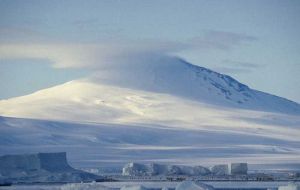MercoPress. South Atlantic News Agency
Massive Antarctic ice shelf breaking up into icebergs

A massive Antarctic ice shelf is breaking up and pieces are expected to float away as icebergs over the course of the next few weeks. Scientists estimate the Wilkins Ice Shelf, which was originally about the size of Northern Ireland, had been in place for several hundred years. But satellite images taken over the past week show it has begun collapsing into the ocean as more than half a dozen similar Antarctic ice shelves have already done, said an article posted Tuesday by the European Space Agency on its website.
The ice shelf is located on the west side of the Antarctic Peninsula, which juts out toward South America and is the northernmost part of Antarctica. Temperatures in the region have been rising about half a degree Celsius per decade for the past 50 years, and researchers are blaming the ice shelf collapse on the warming climate.
As of Tuesday, the ice shelf had lost about 700 square kilometers of ice — about the same area as New York City — over the course of four days, the ESA reported.
The first icebergs began breaking away from the ice shelf on Friday, as shown in images recorded by the European Space Agency's Envistat satellite and the German Aerospace Centre's TerraSAR-X satellite.
The start of the ice shelf's collapse comes three weeks after the breakup of a 40-kilometre-long ice bridge that had connected the ice shelf to Charcot and Latady islands.
Researchers had estimated that without the bridge to buttress it, the shelf would likely lose about half its area over the next few years.
Until recently, the Wilkins Ice Shelf covered 16,000 square kilometers (the size of Northern Ireland). It was stable for most of the last century but began retreating in the 1990s. A major breakaway occurred in 1998, when 1,000 square kilometers of ice were lost in a few months.
The shelf itself is very fragile, as many fractures have formed within it over the past 15 years, the ESA said.
In the wake of the ice bridge collapse, rifts in the ice along the shelf's northern front visibly widened and new cracks formed.
While the bridge disintegrated very quickly, an ESA statement said that icebergs are expected to keep calving off the ice shelf for several weeks.
Angelika Humbert, a researcher at the Institute of Geophysics at Muenster University, and Matthias Braun, a researcher at the University of Bonn's Centre for Remote Sensing, have been monitoring the collapse using the satellite imagery. Humbert reported on the ESA website that it is not clear whether a new stable ice front will form in the area. A collapse of the shelf is not expected to have any effect on sea level because it is already floating.
Other ice shelves that have collapsed over the past 30 years include the Prince Gustav Channel, Larsen Inlet, Larsen A, Wordie, Muller and Jones ice shelves, as well as the Larsen B, which disappeared in just 30 days in 2002




Top Comments
Disclaimer & comment rulesCommenting for this story is now closed.
If you have a Facebook account, become a fan and comment on our Facebook Page!